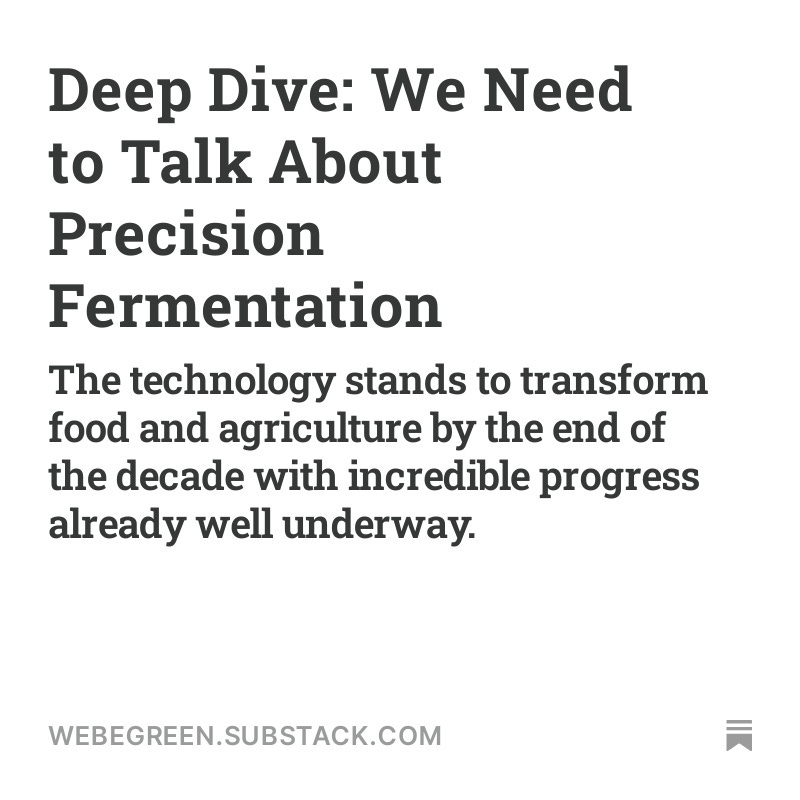We Need to Talk About Precision Fermentation
The technology stands to transform food and agriculture by the end of the decade with incredible progress already well underway.
Read our deep dive into Precisions Fermentation by clicking below:
Precision Fermentation has been around for a while. In 1978, Genentech engineered a bacterium to produce human insulin. Up until then insulin was obtained by harvesting the pancreas of pigs and cows: around 50,000 for a single kilogram of insulin. Thankfully this is no longer the case. 99% of global insulin is now produced by microbes, and yet, very few of us are even aware of this groundbreaking technology. One that could produce almost anything, and in much the same way we make beer.
A little history -
Traditional fermentation relies on microorganisms feeding on sugar to convert an input into a slightly different output, like turning milk into yoghurt or wort into beer. However, Precision Fermentation takes this process further by programming microbes to produce very specific ingredients of interest. The food industry has embraced this technology with both hands: 90% of rennet used for cheesemaking, almost 100% of Vitamin B12, and the vast majority of Vanillin, Betalains and yeast extract currently on the market is made in this way. It’s heavily used by pharmaceuticals too, to produce not only insulin but also human growth hormone (HGH), Penicillin and the Hepatitis-B vaccine. And these examples barely scratch the surface, Precision Fermentation has the potential to produce so much more.
Got Milk? -
L1 Dominette 01449 may not be your first choice for a baby name but it belongs to a very important brown and white Hereford cow. Born on April 14th, 2001, her entire genome was sequenced at the Baylor College of Medicine Human Genome Sequencing Center by April 24th, 2009. The team of researchers created a comprehensive digital record of all her genes. Among these genes, one is responsible for milk production, and thanks to Dominette, we now know exactly where to find it and how to recreate it. By inserting that gene into a chosen microorganism scientists can coax the organism to produce those proteins for us via Precisions Fermentation.

A world of possibilities -
Over the years, publicly available DNA-sequence databases have grown significantly, thanks to scientific contributions. The DNA sequences for many genes and organisms are now widely accessible, meaning we are far from limited to milk. We can, for example, insert genes responsible for making honey, egg-white, cocoa or coffee. The latter two being commodities whose costs have recently skyrocketed because of our changing climate and the resulting shortages. We can also produce non-food-products such as fabric dyes, leather, silk and even collagen from a Mastodon. And all of these, at the fraction of the environmental impact of conventional practices and without animal cruelty.
Some companies such as Nourish Ingredients are producing animal fats to enhance the flavour of plant-based products such as burgers. Others, such as the famous Impossible Burger use the yeast Pichia Patoris to produce Heme, an iron-containing molecule and a primary component of Haemoglobin i.e blood, which gives the burger its meaty flavour.
It's important to mention that these are not Genetically Modified Foods (GMOs). Only the microbe is genetically engineered and not the final product.

A new Age -
Precision Fermentation has enormous potential for planet, health and animals. But whilst it’s been around for decades some products are still very expensive to produce. Milk however is composed of whey and casein and together account for a mere 3.3% of milk's overall composition. And since they can be produced far more efficiently and sustainably through Precision Fermentation, the dairy industry finds itself on the brink of a major disruption. Companies like Perfect Day are leading the way and industry incumbents such as Danone and Fonterra are enthusiastically adopting the technology.
All dairy cows could retire as early as 2030, inflicting a significant blow to the leather and veal industry, the first domino.
To quote RethinkX we are entering the age of a second domestication of plants and animals. The first domestication allowed us to master macro-organisms such as cows and sheep for our food. This second domestication is allowing us to harness microorganisms for a much more sustainable, ethical and healthier food system. One that can return 70% of the land we currently use for agriculture to nature.
Some technologists predict that our current food system will be replaced by a Food-as-Software (FaS) model, one where foods engineered by scientists at a molecular level will be uploaded to databases that can be accessed by food designers anywhere in the world. This could mean milk without the lactose, eggs without the cholesterol, rice fortified in vitamins and minerals, beans with complete protein profiles or foods we can’t even begin to imagine yet, all produced anywhere we can brew beer. This would drastically improve food security and democratise access to nutritious food. Precision Fermentation offers the opportunity for a truly distributed and decentralised food system, one that can guarantee a future where we can all eat a nutritious diet. Not one where the price of chocolate and coffee is greater than gold and reserved for a select few.
Sources:
Precision Fermentation Perfected: Strain Engineering
How we Get Microflora to Create Sustainable Protein - Perfect Day
Precision Fermentation Home Page
The science of fermentation (2024) | GFI
Precision fermentation’s capacity craze: Have we lost the plot? | TechCrunch



